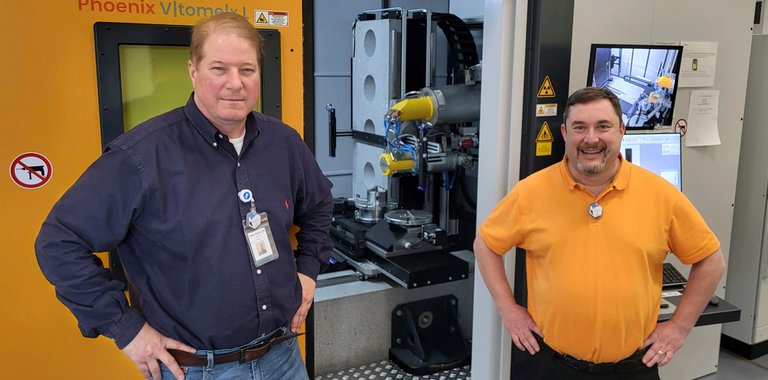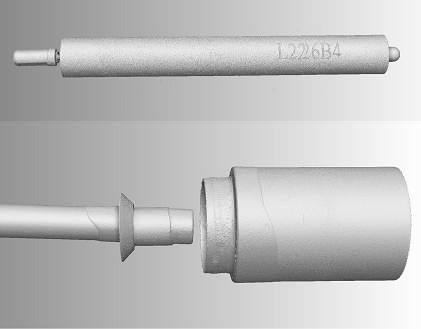
Revolutionizing Nuclear Safety
Baker Hughes’ Reuter-Stokes invests in advanced industrial computed tomography from Waygate Technologies
About Reuter-Stokes: For more than 60 years, Reuter-Stokes scientists and engineers have collaborated with customers to design, produce, and install cutting-edge detection technology in some of the world’s harshest environments. Its solutions include precise radiation measurement, nuclear reactor monitoring, UV flame detection, and downhole sensing for directional drilling.
Some time ago, reflecting its culture of continuous improvement, Reuter-Stokes invested in a Waygate Technologies computed tomography (CT) system for industrial inspection. Both businesses are part of Baker Hughes’ Industrial & Energy Technology (IET) business segment.
Paul Turkal and Jonas Burke are locked away in Reuter-Stokes’ Materials Laboratory at its global headquarters in Twinsburg, Ohio, charged with improving engineering design and inspection capabilities, with the help of the system – or more precisely a CT scanner called Phoenix V|tome|X L300.
A year on from the investment, Paul and Jonas answer some key questions:
- What does the CT scanner do?
- Paul: The CT scanner has the same principles as an X-ray machine but is significantly more powerful, capturing thousands of pictures and millions of data points to form one 3D image.
- Jonas: We can literally see inside our products and components, from plastics to gold, at any and every conceivable angle!
- How is this useful to Reuter-Stokes?
- Paul: In the nuclear sector in particular, there is absolutely no room for error. Our sensors must provide accurate and reliable data. As a result, the manufacture and production of Reuter-Stokes technology must be similarly exact – there is no room for error!
- Jonas: Therefore, using the CT scanner, we can analyze all the components and materials used in the manufacture of our technology. If there is something amiss on dimensions, a defect, or a contaminant present, we can pick it up. Identifying any faults in the early stages of manufacture saves significant amounts of time and reduces our cost of quality overhead.
- Have you got any specific examples where the industrial CT scanner has benefited Reuter-Stokes?
- Paul: We have many examples! For instance, with the help of the CT scanner, we have been able to reduce scrap rates. Using the CT scanner, we can identify the root cause quickly and efficiently. This means that we can offer our customers better on-time delivery and therefore optimize customer satisfaction.
- Jonas: Without the CT scanner, we would have persevered with a trial-and-error approach to identifying issues – which can take a long. In one example we were able to identify a defect in a component in just an hour using the CT scanner.
- Has Reuter-Stokes investment in the CT Scanner been worthwhile?
- Paul: I think it’s already paid for itself! A key advantage is that we can integrate the system at the design stage of a new product. This helps us to avoid making decisions at this stage that could reduce efficiency and slow us down. For existing products, we've also gained so much insight into our products and their components - all this knowledge has helped us make better decisions, improve on-time delivery and reduce the cost of quality.
- Jonas: We anticipated that the CT Scanner investment would achieve ROI within 2.5-years. This was in part predicated on the new business generated from product development. The CT scanner has already revealed details of internal design that will aid that development, including: how to construct new welding and brazing processes so as to create strong and stable joints; whether new cleaning processes are effective in eliminating contamination; and whether the dimensions of new designs can be maintained during assembly and use. We are now in a position to bring new products to market earlier.
... the investment has been worth its weight in gold!
- Are there any other advantages of having the CT scanner?
- Paul: Yes, the investment will also lead to faster development of new products and better quality for customers.
- Jonas: Ultimately, the industrial CT scanner will improve the safety, quality, integrity and consistency of Reuter-Stokes products. We’re well on the road to improving our engineering design and inspection capability… the investment has been worth its weight in gold!
- Was there much collaboration with your sister company Waygate Technologies?
- Paul: Yes, having Waygate Technolgies expertise at our fingertips has always been a real asset. Before we invested in our own CT scanner, we would take some materials to a Waygate Technologies facility in Cincinnati, Ohio. Being part of one organization has made it easy to work together. We got to know the team really well and partnered with them to build a business case for a dedicated CT scanner at Reuter-Stokes headquarters in Twinsburg, Ohio.
- Jonas: That the CT scanner is making a significant contribution to continuous improvement at Reuter-Stokes reflects the benefits of being part of Baker Hughes and the strong collaboration between Waygate Technologies and us.


